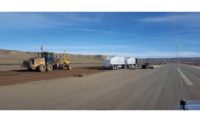Hanksville Utah Airport Runway Reconstruction
Hanksville, Utah
Best Project
Owner: Utah Dept. of Transportation/Jviation
Lead Design Firm: Jviation
General Contractor: Staker Parson Cos. (Nielson Construction & Materials)
The airport in Hanksville, Utah, was built in 1947, and in the post-World War II years served as an emergency landing strip for planes traveling between Denver and Los Angeles. Over the decades, the runway—originally paved with asphalt only 2 in. thick—had become dilapidated, with weeds growing through the cracks. The airport’s lighting system and taxiways also needed upgrading.
The contractor began by pulverizing the runway asphalt and setting the material aside for grading shoulders. The runway was then excavated down 18 in. and the granular material was reprocessed, graded and compacted.
Grading requirements on runways are very stringent and usually challenging to meet. Once the subgrade tolerances had been met, 6 in. of untreated base course was applied. The grading crew prepared the way for paving professionals, who laid down two 1-1/2-in. layers of asphalt—a total of 3 in.—a full inch thicker than the original pavement.
Runways are all about takeoffs and landings, and the new one at Hanksville is exceptionally smooth. After construction, 33 of 43 sections tested had a profilograph index (PrI) of zero in. per mile, or 1 in. for every 10 miles. The PrI measures the accumulated number of inches a vehicle’s suspension jumps while traveling over a mile of pavement. By contrast, the project’s specification for smoothness was 7 in. per mile. The Hanksville airport runway is once again providing smooth takeoffs and landings.
Related Article: Institutional Work Leads Field of 2017 Best Projects Winners





Post a comment to this article
Report Abusive Comment